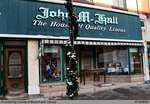Paris and the Beginning of the 1837 Patriot Rebellion
At the time of the 1837 Mackenzie Rebellion the population of Paris was about 800 souls. It contained a mill for processing gypsum, a number of stores, a wagon shop, tannery, distillery, woolen mill, two blacksmiths and at least one tavern.
The rebellion in Upper Canada began in Toronto, led by William Lyon Mackenzie. On December 5th, Mackenzie, upon a white horse, led his motley crew of about one hundred Patriots south down Yonge Street, beginning the Mackenzie rebellion of 1837.
The initial outbreak in the Brant area exploded unto the scene with fiery speeches and promises by Patriot leaders like Dr. Charles Duncombe of Burford and Eliakim Malcolm of Oakland. Yet the leadership and spirit of the Patriots proved no match for Loyalist troops that gathered to defend the Empire. Volunteer companies from Paris, Brantford, Burford, St. George along with Six Nations warriors sprang up overnight to join in the advance and subsequent actions against the fleeing Patriots.
In the tiny village of Paris Forty-four Privates, one Corporal and two Sergeants with their officers formed a Volunteer Guard Company two days later on December 9th.
Paris Volunteer Guard
December 9, 1837 - January 13, 1838
Captain: Robert Battersby Lieutenant: ? Battersby Ensign: George Macartney Sergeant: Thomas Allchin Sergeant: Thomas McHeogh (or McHugh) Corporal: 1 (not named) Privates: 44 (not named)
Part of their first duty would have involved guarding the bridge over the Grand River. The bridges in Galt, Brantford and Cayuga were also guarded night and day to catch fleeing Patriots. Their service also included duty on the Niagara Frontier opposite Navy Island.
Troops that were travelling through Paris along the Governor’s Road were billeted at places like Broomhill Farm (96 Curtis Ave.) on the east side of the Grand River. Broomhill was owned by the local Justice of the Peace, William Granville Curtis. Local settlers would have had to billet troops in their homes. The troops would also have had to be fed and the locals would have been required to provide this food. Hiram Capron's account books have entries that indicate he sold hay to Captain Battersby to feed horses and draft animals.
In February, Isaac Arnold, the Paris Bridge Tollkeeper, wrote to the local military commander complaining that he could not earn a living operating the bridge because he was unable to collect tolls from the troops passing over. We can get a brief glance of troop movements through Paris at that time by Arnold’s description. He said that on a daily basis Express Riders, Dragoons and teams in the service of the army were frequently passing over the bridge.
These bits of information provide brief glimpses of the events going on in Paris at this exciting time in Canadian history. Some were Loyalists and some Patriots, each side struggling to bring about a vision of Canada they believed in. The little contingent of fifty volunteers was a sizeable contribution for a village not yet a decade old. It was the beginning of an honourable tradition of military service that still continues in Paris.




